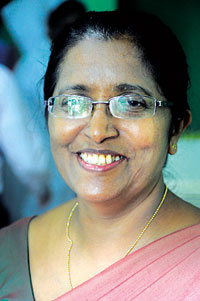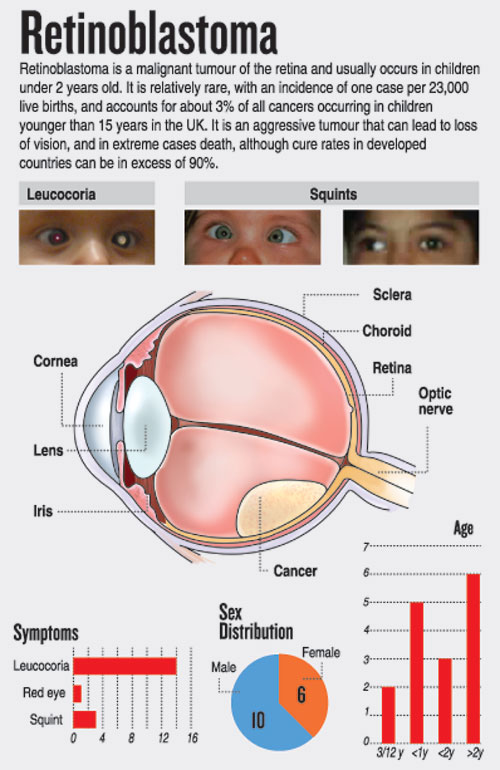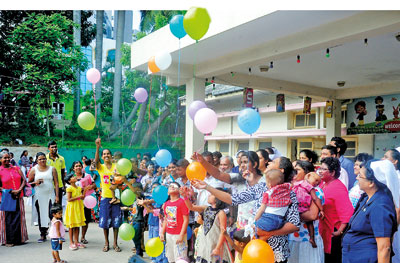Keeping an eye on your child’s eyes
Heads turned up towards the sky, there is laughter as pink, orange, blue, green and yellow balloons bob up and float away. It is a sight for sore eyes at a ‘strange’ location where there is not only anguish and sorrow but also hope and healing.The balloons attract attention and a knot of parents and children form in the garden of the premier Lady Ridgeway Hospital (LRH) at Borellla.

Dr. Dharma Irugalbandara
This is exactly what the pioneering Paediatric Eye Unit headed by Consultant Ophthalmologist Dr. Dharma Irugalbandara along with her team are hoping to do – spread the message on a matter of importance with regard to the eye health of children on World Sight Day on October 12.
Retinoblastoma or a cancerous tumour that grows on the eye’s retina is what the message is all about – catch it early and get it treated, is what we hear at a small session in the busy LRH Outpatients’ Department (OPD), once again with a group of parents and children with many more stopping-by to give ear.
As parents cuddle and hug their babies tight, ‘catching’ retinoblastoma is very easy. Peer closely into their eyes. “Usually, babies eyes glint red, but if you see white on the pupil, the dark circular area in the middle of the iris or the coloured part of the eye, you need to see an eye doctor immediately,” stresses Dr. Irugalbandara, pointing out that if detected early there is treatment.
This rare eye cancer in children is being detected late, MediScene learns, due to neonatal screening not being regular, the myths people believe that squints are good and fear of treatment. The need of the hour is to improve awareness, regularize neonatal screening and strengthen the investigation of squints in children which could also be an early tell-tale sign of retinoblastoma and even other issues of the eye.
Research done in the United Kingdom sheds light on this malignant tumour of the retina – that it generally occurs in children under two years old. It is relatively rare, with an incidence of 1 case per 23,000 live births and accounts for about 3% of all cancers in children younger than 15 years. However, it is an aggressive tumour that can lead to loss of vision and in extreme cases death. But the good news is that cure rates in developed countries can be more than 90%.
In Sri Lanka, that day in October, the stories of hope come from parents. An emotional mother relates how her little girl was diagnosed with retinoblastoma when she was a tender one-year-old. “Babage ehe, sudu bolayak dekka,” she says, explaining that she saw a white ball in her baby’s eye. She sought treatment immediately and now that little one is 10 years old and there are smiles when all the urgings cannot coax the girl to come before the crowd.
 It is a slightly different experience from a mother who says with her voice breaking that she saw something strange, in her baby’s eye at six months but did not know that it was serious. “Ahek dilisenawa dekka,” she adds, explaining that she saw her baby’s eye glistening. It was only when the baby was a 1½-year-old that she was diagnosed with retinoblastoma and that eye had to be removed.
It is a slightly different experience from a mother who says with her voice breaking that she saw something strange, in her baby’s eye at six months but did not know that it was serious. “Ahek dilisenawa dekka,” she adds, explaining that she saw her baby’s eye glistening. It was only when the baby was a 1½-year-old that she was diagnosed with retinoblastoma and that eye had to be removed.
Simply and succinctly, Dr. Diloshini ……..and ………explain the condition in both Sinhala and Tamil. Like a nelum bud that lies under water and suddenly shoots up and a lotus blooms white, the retinoblastoma can be seen within the eye, they say, pointing out that children with this condition are brought either with a squint (wapare), a white patch or sometimes with swollen red eyes. The tumour could be in one or both eyes. The important thing is for parents who would necessarily spot this early to take the child to an eye clinic. Then as a diagnosis cannot be made by looking at the eye externally, the eye doctors would dilate (make larger) the child’s eye and take a closer look at the inside of the eye.
Usually, it would be in children below two years old, but we have also come across older children, they say, lamenting that time has passed and tragically the cancer has also spread, sometimes from the eye onto the body. There have been 23 new cases of retinoblastoma in 2016 and 27 in 2015, MediScene learns. The gender distribution in 2016 was 10 boys and six girls, while the cancerous tumour had arisen unilaterally (affecting one eye) in 11 and bilaterally (affecting both eyes) in 7.
Taking up the issue of a squint, they plead with parents not to think that it is “a ping wapare” or that it would go away as the child grows up. Just see an eye doctor and check it out. Even if there is the slightest suspicion that something is wrong with your child, get the child screened.
They pick up the different cases, citing the statistics of 2016:
Leucocoria – The appearance of white in the black of the eye, with some parents saying “jill bolayak dekka” (saw a white marble). A majority presented with this symptom.

Marking World Sight Day on October 12 at the LRH. Pic by Amila Gamage
Squints (strabismus) – This is a condition where the eyes do not look in the same direction. The squint could be inward (esotropia); outwards (exotropia); upwards (hypertropia) or downwards (hypotropia). After leucocoria, this was the next highest presentation of symptoms.
Swelling and redness – Regrettably, this would be when the tumour has spread. This came in third place.
The spread of the tumour can be grouped into five.
Stages A & B – A small tumour which is confined to the retina.
Stages C, D & E – The tumour has invaded the tissue and spaces adjacent to the eye.
Reiterating that everything depends on how early a child is brought to an eye clinic, they say that it is then that the treatment in the form of chemotherapy and laser works. Sometimes we have to operate and remove the eye because an eye with a cancerous tumour is like a bomb ticking within the head of the baby. After the removal of the eye, an artificial eye can be put in its place.
Citing the case of a nine-month-old brought in early with retinoblastoma – a large unilateral tumour – they point out how eight weeks of chemotherapy reduced it considerably. However, they caution that “constant watch” has to be kept and continued.
If in case the mother of a baby has had an eye operation linked to cancer, there is a pre-disposition of her children getting it and as such these mothers should be advised to be more alert.
| Genetic screening available too Bilateral retinoblastoma, multiple tumours in one eye or the condition being hereditary is a pointer towards a genetic abnormality, says Dr. Dharma Irugalbandara, giving the good news that the Eye Unit at the LRH is conducting genetic screening.If one child has had a retinoblastoma, mothers in those families who are expecting another child should get the babies in their wombs scanned and screened for this condition, she advises. | |


